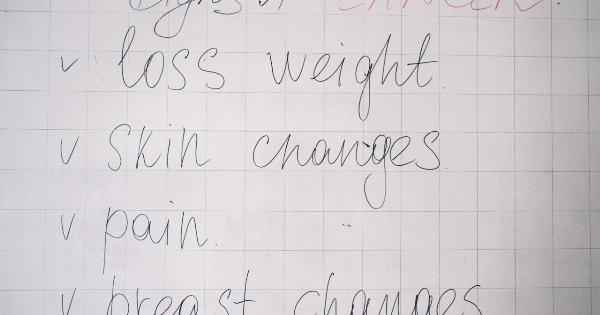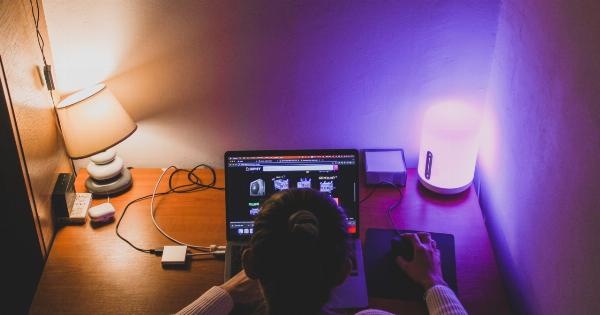Back pain is a common condition that affects millions of people worldwide. It can range from mild discomfort to severe, debilitating pain that interferes with daily activities.
While there are several potential causes of back pain, one often overlooked factor is the narrow zone.
Understanding the Narrow Zone
The narrow zone refers to the space between the vertebrae in the spine. This area is responsible for providing stability and allowing for movement.
When the narrow zone becomes compressed or restricted, it can lead to back pain and other related symptoms.
Causes of Narrow Zone Compression
There are several factors that can contribute to the compression of the narrow zone, including:.
1. Poor Posture
Sitting or standing with poor posture can place excessive strain on the spine, leading to compression of the narrow zone. Slouching or hunching forward can cause the vertebrae to shift out of alignment, resulting in pain and discomfort.
2. Prolonged Sitting
Remaining in a seated position for extended periods can also contribute to narrow zone compression. Sitting puts additional pressure on the vertebrae and can cause them to compress, leading to back pain.
3. Obesity
Excess weight puts strain on the spine, leading to compression of the narrow zone. The added pressure can cause the vertebrae to compress and result in chronic back pain.
4. Lack of Exercise
A sedentary lifestyle can weaken the muscles that support the spine, leading to increased pressure on the narrow zone. Regular exercise helps keep these muscles strong and prevents compression of the vertebrae.
5. Injury or Trauma
An injury or trauma to the back can disrupt the alignment of the vertebrae and compress the narrow zone. This can result in acute or chronic back pain, depending on the severity of the injury.
6. Degenerative Conditions
Conditions such as arthritis or degenerative disc disease can cause the vertebrae to deteriorate over time, narrowing the space between them. This narrowing can lead to compression of the narrow zone and subsequent back pain.
7. Herniated Discs
A herniated disc occurs when the soft inner core of a spinal disc protrudes through the outer layer. This can compress the narrow zone and cause pain. The location of the herniation determines the area of the back that is affected.
8. Muscle Imbalances
Imbalances in the muscles surrounding the spine can lead to uneven pressure on the narrow zone, resulting in pain and discomfort. Weak abdominal muscles, for example, can cause excessive pressure on the lower back.
9. Stress
Stress and tension can cause the muscles in the back to tighten, leading to increased compression of the narrow zone. Chronic stress can contribute to chronic back pain.
10. Poor Lifting Techniques
Improper lifting techniques, such as lifting heavy objects with your back instead of your legs, can strain the muscles and compress the narrow zone. This can result in acute or chronic back pain.
Treating Narrow Zone-Related Back Pain
There are several treatment options available for managing back pain caused by narrow zone compression, including:.
1. Physical Therapy
A physical therapist can develop an exercise program tailored to your specific needs. This may include stretches and strengthening exercises to improve the stability and flexibility of the narrow zone.
2. Posture Correction
Working with a physical therapist or a posture specialist can help correct posture issues that contribute to narrow zone compression. They can provide guidance on how to maintain proper alignment and reduce strain on the spine.
3. Pain Medication
Over-the-counter or prescription pain medication can help alleviate pain caused by narrow zone compression. Nonsteroidal anti-inflammatory drugs (NSAIDs) may also help reduce inflammation in the affected area.
4. Hot and Cold Therapy
Applying heat or cold to the affected area can help reduce inflammation and alleviate pain.
Heat therapy, such as using a heating pad, can help relax the muscles, while cold therapy, such as applying an ice pack, can help numb the area and reduce swelling.
5. Lifestyle Modifications
Making changes to your daily habits can have a significant impact on back pain caused by narrow zone compression.
This may include maintaining good posture, taking frequent breaks from sitting, losing weight if necessary, and incorporating regular exercise into your routine.
6. Massage Therapy
Massage therapy can help relax tight muscles, improve circulation, and reduce pain caused by narrow zone compression. A skilled massage therapist can target specific areas of tension and provide relief.
7. Injections
In some cases, injections of anti-inflammatory medications or steroids may be recommended to reduce inflammation and provide temporary pain relief. These injections are typically administered directly into the affected area.
8. Surgery
If conservative treatments fail to provide relief, surgery may be considered as a last resort. Surgical intervention may be necessary to address underlying issues that contribute to narrow zone compression, such as herniated discs or spinal stenosis.
Preventing Narrow Zone-Related Back Pain
While it may not always be possible to prevent back pain entirely, there are steps you can take to reduce the risk of narrow zone compression and subsequent pain:.
1. Maintain Good Posture
Sit and stand with your back straight, shoulders relaxed, and feet flat on the floor. Use ergonomic furniture and support devices, if needed, to promote proper alignment.
2. Exercise Regularly
Incorporate exercises that strengthen the core muscles into your routine. Strong core muscles provide support to the spine and help prevent narrow zone compression.
3. Practice Safe Lifting Techniques
When lifting heavy objects, bend your knees and lift with the strength of your legs instead of your back. Avoid twisting or jerking motions while lifting.
4. Take Breaks from Sitting
If your job requires prolonged sitting, make an effort to take regular breaks and stretch. Stand up, walk around, and change positions frequently to reduce pressure on the spine.
5. Maintain a Healthy Weight
Excess weight puts strain on the spine, contributing to narrow zone compression. Maintain a healthy weight through a balanced diet and regular exercise to reduce the risk of back pain.
Conclusion
The narrow zone plays a vital role in the stability and flexibility of the spine. When this area becomes compressed or restricted, it can lead to back pain and discomfort.
Recognizing the potential causes of narrow zone compression and taking steps to prevent and treat it can help alleviate back pain and improve overall spinal health.




























